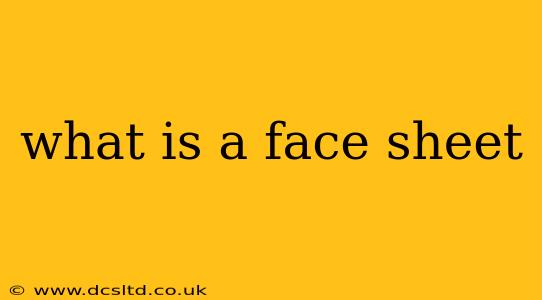A face sheet, in its simplest form, is a concise summary of key information related to a specific individual, project, or event. Think of it as a quick snapshot providing the most crucial details at a glance. While the specific content varies greatly depending on the context, the underlying goal remains the same: efficient information dissemination. This guide will explore the diverse applications of face sheets and delve into their specific components.
What information does a face sheet usually include?
The information contained within a face sheet is highly contextual. However, common elements include:
-
Identifying Information: This is usually the most prominent section, featuring the name, contact details (phone number, email address, etc.), and potentially other unique identifiers depending on the application (e.g., employee ID, patient ID).
-
Key Details: This section varies wildly. In a medical context, this might involve allergies, medical history, or current medications. For a project, it could encompass deadlines, budget information, or key stakeholders. For a sales lead, it might list their company, job title, and purchase history.
-
Status Updates (where applicable): Especially for projects or ongoing processes, the face sheet might include a brief overview of the current progress, highlighting key milestones achieved and any roadblocks encountered.
-
Relevant Documents (links or references): Face sheets often serve as a central hub, linking to more detailed information elsewhere. This could include links to files, databases, or other relevant resources.
What are the different types of face sheets?
The term "face sheet" is used across numerous industries, and its specific content varies considerably. Here are some examples:
-
Medical Face Sheets: Used in healthcare settings, these provide a summary of a patient's vital information, medical history, and current treatment plan, ensuring quick access to critical data during emergencies or routine check-ups.
-
Project Face Sheets: Used in project management, these sheets offer a concise overview of a project's status, key personnel, milestones, budget, and deadlines. This allows for efficient monitoring and communication among team members.
-
Sales Face Sheets (Lead Sheets): In sales, these sheets summarize crucial information about potential clients, including contact details, company information, purchasing history, and interactions with the sales team. This aids in personalized outreach and improved sales strategies.
-
Event Face Sheets: For events, these documents might include details about the venue, date, time, attendees, speakers, and a summary of the event's purpose or agenda.
What are the benefits of using face sheets?
The primary advantage of face sheets lies in their efficiency. By presenting essential information concisely, they facilitate:
-
Quick Information Access: Crucial details are readily available at a glance, saving time and effort.
-
Improved Communication: They serve as a standardized method for communication, minimizing misunderstandings and ensuring everyone is on the same page.
-
Enhanced Decision-Making: The readily available summary of key information makes informed decisions much easier.
-
Better Organization: Face sheets contribute to a more organized workflow, especially in complex projects or scenarios involving numerous stakeholders.
How can I create a face sheet?
Creating a face sheet is straightforward. Use a spreadsheet program (like Excel or Google Sheets) or a word processor (like Word or Google Docs). The key is to prioritize clarity and conciseness. Structure the information logically, using clear headings and bullet points to enhance readability. Remember to tailor the content to the specific needs of the context.
What software can I use to create a face sheet?
Numerous software options can be used to create face sheets. These include, but are not limited to:
- Microsoft Excel/Google Sheets: Ideal for creating structured data summaries.
- Microsoft Word/Google Docs: Suitable for creating more narrative-style summaries.
- Specialized Project Management Software: Many platforms include features for creating project-specific face sheets.
- CRM Software: Customer Relationship Management systems often incorporate lead sheets/face sheets as a core feature.
This comprehensive guide provides a thorough understanding of what a face sheet is, its various applications, and the benefits it offers. By understanding the power of concise information summarization, you can leverage face sheets to streamline your workflows and improve efficiency across numerous contexts.
